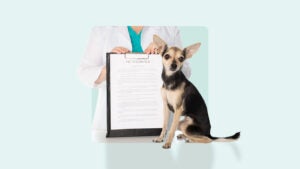What causes pet insurance premiums to go up over time?

Pet insurance can be a lifesaver when unexpected veterinary costs arise, and it’s often quite affordable. However, those low premiums may not stay the same throughout your pet’s life.
Factors such as your pet’s age, inflation and improved veterinary technology can cause your pet insurance premiums to increase over time. Whether you’re a first-time pet owner or looking to renew your current plan, awareness of cost components can help you make more informed decisions when choosing a policy.
How pet insurance companies determine rates
Insurance products are risk dependent. In other words, the more risk (senior pets, pre-existing conditions) or exposure (higher reimbursement rate, lower deductible) the insurance provider faces, the higher the premiums are. In pet insurance, your insurer will consider risks across several key areas.
Species
One of the first things insurers consider when determining insurance premiums is whether your pet is a dog, cat or something else.
Generally, dogs are more expensive to insure than cats due to their size, higher risk of injury, and the cost of treatments associated with common canine conditions. Horse insurance can be even pricier than cat and dog insurance due to the cost of treating equine pets. Exotic pets, if covered, often have specialized rates based on their unique medical needs.
Breed
Some insurance providers will consider your pet’s breed when determining the insurance cost. Certain breeds are more prone to genetic conditions and health problems than others.
For instance, larger dog breeds like Great Danes or mastiffs are likelier to experience joint issues, while miniature poodles and boxers are more liable to develop heart disease. Purebred dogs and cats typically have higher rates than mixed breeds, as they are often at risk for specific hereditary conditions.
Age
Age is another critical factor in setting pet insurance rates. Younger pets are usually cheaper to insure because they are generally healthier and less prone to age-related diseases. As pets age, they’re more likely to develop chronic illnesses such as arthritis, cancer and diabetes.
These factors drive up premiums. In some cases, insurers may even restrict coverage for very senior pets or charge substantially higher rates to offset the risk of insuring an aging animal.
Location
Where you live can have a significant impact on your pet insurance rates. Areas with higher living costs tend to have more expensive veterinary bills, which can lead to higher premiums.
Pet owners in large cities like New York or San Francisco may pay more for pet insurance than those in rural areas, where the cost of care is lower. Additionally, certain regions may have a higher prevalence of specific risks, like tick-borne diseases or wildlife encounters, which could further affect rates.
Type of pet insurance
The type of insurance coverage you choose also influences your premium. Pet insurance companies typically offer three types of plans, from basic accident-only coverage to more comprehensive policies that include illness, preventive care and even wellness treatments.
A plan that only covers accidents will be less expensive than one that covers chronic diseases or routine veterinary visits. Additionally, policies with higher annual limits, lower deductibles or broader coverage options will come with higher premiums because they offer more protection.
Factors that cause premiums to go up over time
While no one likes to see their pet insurance premiums increase, understanding the factors behind the hikes can help you prepare. Your pet’s age, your pet’s medical history and broader trends in veterinary care and economics all play a role in determining your rates. By monitoring these elements, you can ensure you’re prepared for any changes in your premiums over time.
Your pet’s age
Older cats and dogs may need more frequent veterinary visits, tests and treatments. As a result, insurers view older pets as higher risk and thus charge more to insure them.
Even if your fur kid is healthy now, the potential for future claims rises with age. Insurance companies adjust their rates to account for the likelihood of covering more medical expenses down the road.
Your pet’s medical history
If your furry friend has a history of illnesses, injuries or chronic conditions, your premiums may go up. For example, if your pet has developed a chronic condition like diabetes or hypothyroidism, the insurance company may increase premiums to offset the likelihood of paying for ongoing treatment.
Advancements in veterinary technology
Veterinary medicine constantly evolves, and new technologies and treatments frequently become available. While these advancements can lead to better care for your pet, they often come with higher costs.
As the price of veterinary care rises due to these innovations, insurers may increase premiums to cover the higher potential payouts for these sophisticated treatments.
Inflation
Like most goods and services, veterinary care is affected by general inflation. Over time, the cost of veterinary supplies, staff wages, rent and other operational expenses rise. These increased costs are passed on to pet owners through higher vet bills. Pet insurance companies may then raise premiums to keep pace with inflation.
Even if your pet’s needs haven’t changed, the overall cost of care can lead to premium hikes.
Pet health trends
Broad health trends among pets can also influence insurance premium increases. Insurance companies may raise premiums across the board to cover the higher likelihood of claims if certain diseases or conditions become more common in pets — such as an increase in obesity-related illnesses.
Additionally, trends in pet ownership, such as a rise in the number of purebred pets, can also impact premiums. If insurers see an uptick in claims related to certain conditions or breeds, they may adjust their rates to reflect the greater financial risk.
How to keep pet insurance costs manageable over time
As your pet ages and premiums increase, it’s helpful to explore ways to keep pet insurance costs manageable while still providing the necessary coverage. Here are some strategies you can consider.
Raise your deductible
One of the easiest ways to lower your monthly premium is by adjusting your deductible. By opting for a higher deductible, you agree to pay more out of pocket before the insurance kicks in, but your monthly premium will be lower.
This option works well for pet owners who are comfortable covering smaller expenses while protecting themselves from large, unexpected veterinary bills. Just be sure you can afford the higher deductible if a major medical issue arises.
Reduce your reimbursement rate
Most pet insurance policies offer flexibility when it comes to reimbursement rates. Lowering your reimbursement rate can help reduce your monthly premium, as the insurance company will be responsible for covering a smaller portion of your bills. This trade-off can make sense for relatively healthy pets or owners prepared to handle a greater share of the costs if something unexpected happens.
Choose less comprehensive coverage
As your furry friend ages, you may want to re-evaluate whether you need the most comprehensive plan. If your current policy covers preventive services, consider switching to an accident-and-illness-only plan. By trimming back coverage for routine visits or smaller treatments, you can significantly reduce your monthly premium without sacrificing protection for big-ticket items.
Check for discounts
Many pet insurance companies offer discounts that can help make premiums more affordable. Some companies even reward loyal customers or offer perks for remaining claim-free for a certain period. Ask your insurer if there are any discounts or special promotions available.
When to consider switching insurance providers
While staying with your current insurer may seem like the easiest option, there are situations where making the switch could benefit your wallet and your pet. Here are some key moments when you should consider switching pet insurance providers.
Premiums become unaffordable
As your pet ages, it’s common for rates to go up. However, if the increases are steep or seem disproportionate to the coverage offered, other insurers may offer better deals. If your current provider has consistently increased premiums to the point where they’re no longer affordable, it might be time to shop around.
Coverage is no longer adequate
As your pet’s needs change, their insurance coverage should evolve too. If your current policy doesn’t adequately cover common medical treatments for your pet’s breed, age or condition, you may need to switch to a provider with more comprehensive coverage.
You’re unhappy with customer service
If you’ve experienced delays, poor communication or dissatisfaction with claim handling, it may be a sign to switch providers. Pet insurance companies should make the process of filing claims and getting reimbursed easy and transparent. If you frequently encounter long wait times, claim denials or confusion over coverage, a different insurer with a reputation for better customer service and faster claims processing might be a better fit.
Newer policies have better benefits
The pet insurance market is competitive. Sometimes, new plans offer better benefits or flexibility compared to older plans. You might discover that a different provider has policies with higher annual limits, lower deductibles or wellness options that your current policy lacks. Switching to a more modern plan could improve your pet’s coverage and save you money in the long run.
Your pet’s health changes
If your four-legged friend develops a serious illness or chronic condition, it might make sense to explore other options. Be mindful, however, that most insurers won’t cover pre-existing conditions, so this option may only apply if your pet is relatively healthy or you find a provider that offers special coverage.
Next steps
Understanding the factors that affect pet insurance premium increases is key to managing your pet’s health care costs over time. From the species and breed of your pet to its age, medical history and even location, various elements can contribute to rising premiums.
While it’s natural for premiums to increase as your pet ages, you can take steps to keep costs manageable. Consider adjusting your deductible, lowering your reimbursement rate or exploring less comprehensive coverage options. Take advantage of available discounts or consider switching providers if your needs change.
Now that you’re familiar with the factors driving premium increases, the next step is to review your current policy and evaluate whether it still meets your needs. Consider whether it’s time to adjust your coverage, explore discounts or compare quotes from other insurers. By staying informed and proactive, you can find the right balance between affordable premiums and suitable care for your pet.
Why we ask for feedback Your feedback helps us improve our content and services. It takes less than a minute to complete.
Your responses are anonymous and will only be used for improving our website.
You may also like

What is pet dental insurance and what does it cover?

What pet insurance companies offer no waiting period?


How are pet insurance premiums determined?


